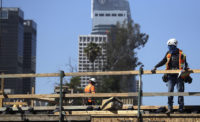Emissions from California�s construction and other off-road diesel equipment are less than 28% of what state officials have estimated, according to a recently released study by the Associated General Contractors of America.
As a result, the California Air Resources Board has no scientific justification for sticking to a new rule requiring construction contractors to spend billions of dollars on their existing equipment, the AGC says.
�There is no scientific reason for the CARB to pursue its punishing off-road rule,� says Mike Kennedy, the association�s general counsel. �The good news is that the board can protect construction and other jobs and still improve the quality of California�s air.�
The new emissions study is based primarily on data assembled by board officials last year, including how many pieces of off-road diesel equipment are in use and how much they run, Kennedy notes. As it turns out, there are 157,000 pieces of this equipment in the state, and not the 192,000 that the staff assumed, and 7.5% of this equipment is low use. Other new data came from the state Board of Equalization, the U.S. Department of Energy and records detailing the actual hours worked by equipment operators. Using this new data, the AGC says researchers found that state officials have vastly overestimated emissions from the state�s off-road diesel fleet. Emissions parallel the consumption of diesel fuel, and in 2009, off-road equipment burned only 164 million gallons of this fuel. If the board�s original estimates were correct, that number would have reached 581 million.
Without any rule, future emissions of nitrogen oxides will be 64% to 74% below the state�s emissions goals through 2025, Kennedy says. Future emissions of particulate matter will be more than 30% below the state�s emissions goals through 2019, he adds.
Kennedy urges board officials to eliminate their rule�s distinctions between fleets of different sizes, and to treat all fleets as if they were small. He notes that the cleanest construction equipment will become available in 2015.
�Giving the industry a little more time won�t put the state�s air quality targets at risk, but it will give thousands of construction workers a chance to resume their careers and rebuild their lives,� Kennedy says.
New construction employment figures for metropolitan areas in California underscore how badly the recession has hurt the state�s construction industry, Kennedy adds. He said that 26 out of 28 metro areas in the state lost construction jobs between March 2009 and 2010, while the other two remained stable.
Sacramento lost one out of every five construction jobs (8,300 jobs, 19%) over the past year. El Centro lost the highest percentage of jobs (29%, 500 jobs), while the Los Angeles area lost the most jobs (22,700 jobs, 18%). Napa (27%, 800 jobs); San Luis Obispo (26%, 1,500 jobs); and Chico (24%, 600 jobs) also experienced high rates of job losses.
Kennedy notes that only Hanford and Yuba City escaped any construction job losses, reporting no change in employment levels between March 2009 and 2010.


Post a comment to this article
Report Abusive Comment